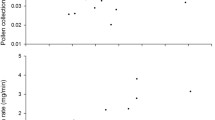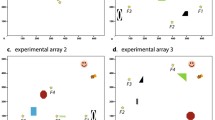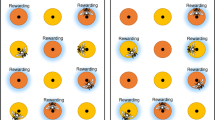Abstract
If the cognitive performance of animals reflects their particular ecological requirements, how can we explain appreciable variation in learning ability amongst closely related individuals (e.g. foraging workers within a bumble bee colony)? One possibility is that apparent ‘errors’ in a learning task actually represent an alternative foraging strategy. In this study we investigate the potential relationship between foraging ‘errors’ and foraging success among bumble bee (Bombus terrestris) workers. Individual foragers were trained to choose yellow, rewarded flowers and ignore blue, unrewarded flowers. We recorded the number of errors (visits to unrewarded flowers) each bee made during training, then tested them to determine how quickly they discovered a more profitable food source (either familiar blue flowers, or novel green flowers). We found that error prone bees discovered the novel food source significantly faster than accurate bees. Furthermore, we demonstrate that the time taken to discover the novel, more profitable, food source is positively correlated with foraging success. These results suggest that foraging errors are part of an ‘exploration’ foraging strategy, which could be advantageous in changeable foraging environments. This could explain the observed variation in learning performance amongst foragers within social insect colonies.





Similar content being viewed by others
References
Alford DV (1975) Bumblebees. Davis-Poynter, London
Burns JG, Dyer AG (2008) Diversity of speed-accuracy strategies benefits social insects. Curr Biol 18:953–954
Chittka L (1998) Sensorimotor learning in bumblebees: long-term retention and reversal training. J Exp Biol 201:515–524
Chittka L, Thomson JD, Waser NM (1999) Flower constancy, insect psychology, and plant evolution. Naturwissenschaften 86:361–377
Chittka L, Spaethe J, Schmidt A, Hickelsberger A (2001) Adaptation, constraint, and chance in the evolution of flower colour and pollinator colour vision. In: Chittka L, Thomson JD (eds) Cognitive ecology of pollinators. Cambridge University Press, New York, pp 21–40
Chittka L, Dyer AG, Bock F, Dornhaus A (2003) Bees trade off foraging speed for accuracy. Nature 424:388
Cole EF, Morand-Ferron J, Hinks AE, Quinn JL (2012) Cognitive ability influences reproductive life history variation in the wild. Curr Biol 22:1808–1812
Deneubourg JL, Aron S, Goss S, Pasteels JM (1987) Error, communication and learning in ant societies. Eur J Oper Res 30:168–172
Dukas R, Bernays EA (2000) Learning improves growth rate in grasshoppers. Proc Natl Acad Sci USA 97:2637–2640
Dyer AG, Dorin A, Reinhardt V, Garcia JE, Rosa MGP (2014) Bee reverse-learning and intra-colony differences: simulations based on behavioral experiments reveal benefits of diversity. Ecol Model 277:119–131
Evans LJ, Raine NE (2014) Changes in learning and foraging behaviour within developing bumble bee (Bombus terrestris) colonies. PLoS One 9:e90556
Faegri K, Van Der Pijl L (1980) The principles of pollination ecology. Pergamon Press Ltd., Oxford
Forrest J, Thomson JD (2009) Pollinator experience, neophobia and the evolution of flowering time. Proc R Soc B 276:935–943
Godin J-GJ, Keenleyside MHA (1984) Foraging on patchily distributed prey by a cichlid fish Teleostei cichlidae a test of the ideal free distribution theory. Animal Behav 32:120–131
Goulson D (2010) Bumblebees behaviour, ecology, and conservation, 2nd edn. Oxford Biology, New York
Healy SD (2012) Animal Cognition: the trade-off to being smart. Curr Biol 22:840–841
Healy SD, de Kort SR, Clayton NS (2005) The hippocampus, spatial memory and food hoarding: a puzzle revisited. Trends Ecol Evol 20:17–22
Heinrich B (1976) Foraging specializations of individual bumblebees. Ecol Monogr 46:105–128
Heinrich B (1979a) Bumblebee economics. Harvard University Press, Cambridge
Heinrich B (1979b) Majoring and minoring by foraging bumblebees, Bombus vagans: experimental analysis. Ecology 60:245–255
Ings TC (2007) Body size affects nectar uptake rates in bumblebees (Hymenoptera: Apidae: Bombus terrestris). Entomol Gen 30:186
Ings TC, Chittka L (2008) Speed-accuracy tradeoffs and false alarms in bee responses to cryptic predators. Curr Biol 18:1520–1524
Katsnelson E, Motro U, Feidman MW, Lotem A (2011) Individual learning ability predicts social-foraging strategy in house sparrows. Proc R Soc B 278:582–589
Keasar T, Motro U, Shmida A (2013) Temporal reward variability promotes sampling of a new flower type by bumblebees. Anim Behav 86:747–753
Laverty TM (1994) Bumble bee learning and flower morphology. Anim Behav 47:531–545
Laverty TM, Plowright RC (1988) Flower handling by bumblebees: a comparison of specialists and generalists. Anim Behav 36:733–740
Menzel R (2001) Behavioral and neural mechanisms of learning and memory as determinants of flower constancy. In: Chittka L, Thomson JD (eds) Cognitive ecology of pollinators. Cambridge University Press, New York, pp 21–40
Milinski M (1984) Competitive resource sharing: an experimental test of a learning rule for ESSs. Anim Behav 32:233–242
Morand-Ferron J, Wu G-M, Giraldeau L-A (2011) Persistent individual differences in tactic use in a producer-scrounger game are group dependent. Anim Behav 4:811–816
Muller H, Chittka L (2008) Animal personalities: the advantage of diversity. Curr Biol 18:961–963
Muller H, Grossmann H, Chittka L (2010) ‘Personality’ in bumblebees: individual consistency in responses to novel colours? Anim Behav 80:1065–1074
Ottoni EB (2000) EthoLog 2.2: a tool for the transcription and timing of behavior observation sessions. Behav Res Methods Instrum Comput 32:446–449
Raine NE, Chittka L (2007) Pollen foraging: learning a complex motor skill by bumblebees (Bombus terrestris). Naturwissenschaften 94:459–464
Raine NE, Chittka L (2008) The correlation of learning speed and natural foraging success in bumble-bees. Proc R Soc B 275:803–808
Raine NE, Chittka L (2012) No trade-off between learning speed and associative flexibility in bumblebees: a reversal learning test with multiple colonies. PLoS One 7:e45096
Raine NE, Ings TC, Ramos-Rodriguez O, Chittka L (2006) Intercolony variation in learning performance of a wild British bumblebee population (Hymenoptera: Apidae: Bombus terrestris audax). Entomol Gen 28:241–256
Spaethe J, Weidenmüller A (2002) Size variation and foraging rate in bumblebees (Bombus terrestris). Insect Soc 49:142–146
Stone GN, Gilbert F, Willmer P, Potts S, Semida F, Zalat S (1999) Windows of opportunity and the temporal structuring of foraging activity in a desert solitary bee. Ecol Entomol 24:208–221
Tanner DA, Visscher K (2006) Do honey bees tune error in their dances in nectar-foraging and house-hunting? Behav Ecolo Sociobiol 59:571–576
Tanner DA, Visscher PK (2010) Does imprecision in the waggle dance fit patterns predicted by the tuned-error hypothesis? J Insect Behav 23:180–188
Towne WF, Gould JL (1988) The spatial precision of the honey bees’ dance communication. J Insect Behav 1:129–156
Weidenmüller A, Seeley TD (1999) Imprecision in waggle dances of the honeybee (Apis mellifera) for nearby food sources: error or adaptation? Behav Ecol Sociobiol 46:190–199
Willmer P (2011) Pollination and floral ecology. Princeton University Press, New Jersey
Willmer PG, Stone GN (2004) Behavioral, ecological, and physiological determinants of the activity patterns of bees. Adv Study Behav 34:347–466
Acknowledgments
We would like to thank Amy Ballard, Gemma Baron, Mark Brown, Lars Chittka, Richard Gill, Oscar Ramos-Rodriguez, Karen Smith and Dara Stanley for comments and/or technical assistance. LJE was funded by Plant and Food Research Ltd New Zealand, a C. Alma Baker Scholarship, an Allan and Grace Kay Overseas Scholarship and a Queen Elizabeth’s Technicians Award.
Author information
Authors and Affiliations
Corresponding author
Electronic supplementary material
Below is the link to the electronic supplementary material.
Rights and permissions
About this article
Cite this article
Evans, L.J., Raine, N.E. Foraging errors play a role in resource exploration by bumble bees (Bombus terrrestris). J Comp Physiol A 200, 475–484 (2014). https://doi.org/10.1007/s00359-014-0905-3
Received:
Revised:
Accepted:
Published:
Issue Date:
DOI: https://doi.org/10.1007/s00359-014-0905-3




